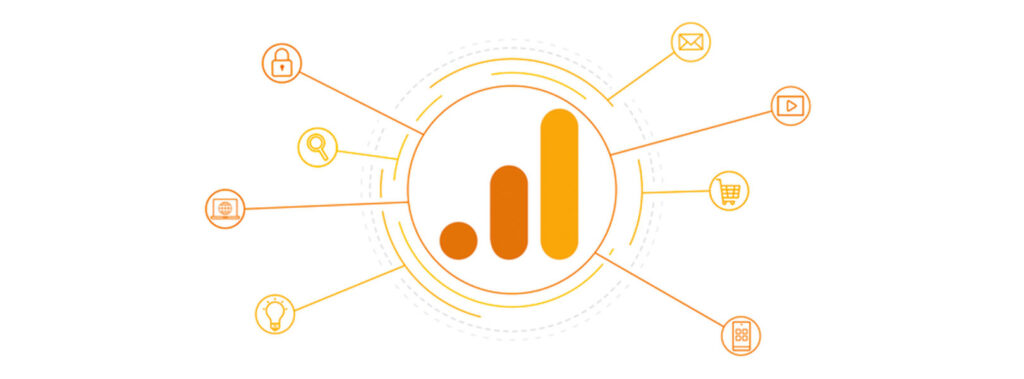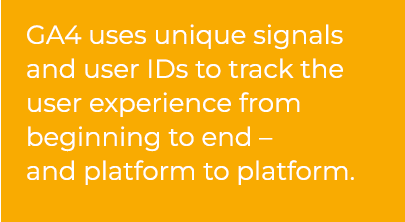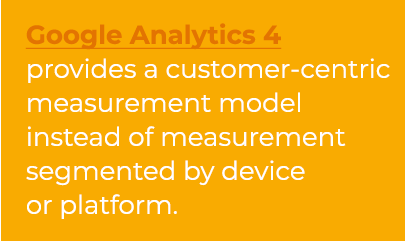With millions of businesses relying on Google Analytics to track user activity on websites, mobile apps, and offline APIs, Google’s reporting tool has become THE industry standard for website analytics. Most marketing teams (ours included) use Google Analytics to help monitor their digital marketing channels, measure campaign results and track KPIs.
Change, however, is on the horizon. Google recently announced that Google Analytics 4 (GA4) will be fully replacing the current version – Universal Analytics (UA) – in 2023.
Formerly known as “App + Web,” Google Analytics 4 (GA4) is the next generation of web analytics that provides marketers with a solid foundation to measure customer behavior and track performance. GA4 is the ideal add-on to your current Google Analytics platform with its new reporting functions, enhanced features, and predictive insights.
Why the Shift to Google Analytics 4?
Google Analytics helps businesses of all sizes to understand their customer behavior and create more compelling experiences. In the modern era of eCommerce and rapid Digital Transformation, companies are under more pressure than ever to make every marketing dollar count. As a result, having insights from digital analytics tools that improve data-driven marketing decisions and produce a higher return on investment (ROI) is no longer an aspirational marketing goal – it is an essential part of any cohesive strategy to future-proof your marketing efforts.

According to Vidhya Srinivasan, VP/GM of Buying, Analytics, and Measurement at Google Ads, this “new, more intelligent Google Analytics builds on the foundation of the App + Web property we introduced in beta last year. It has machine learning at its core to automatically surface helpful insights and gives you a complete understanding of your customers across devices and platforms. It’s privacy-centric by design, so you can rely on Analytics even as industry changes like restrictions on cookies and identifiers create gaps in your data.”
As noted, the latest generation of Google Analytics markets itself as being privacy-focused, addressing recent privacy laws, like GDPR and CCPA. Privacy-first tracking, artificial intelligence (AI) driven predictive analytics, and cross-channel data measurement make GA4 a robust property that drives multiple benefits for websites and apps. Let’s dive into this a bit more…
Google Analytics 4: Important Dates You Need to Know
There are a few dates and details to be aware of.
Which property are you on? If you created your account before October 14, 2020, you are most likely on a Universal Analytics property. Conversely, if you set up your account after October 14, 2020, you are probably on a GA4 property, and no action is necessary. And if you create a new account now, GA4 will be the default.
Not sure which property you have? Click here to see if you have a Universal Analytics property or a Google Analytics 4 property.
When will UA be retired? Google recently announced that it will fully sunset Universal Analytics in 2023. Starting July 1, 2023, Standard Universal Analytics properties will no longer process data. Google states that you will continue to be able to see your Universal Analytics reports for about six months (end of 2023), but new data will ONLY flow into GA4 properties.
One caveat: A one-time processing extension (ending on October 1, 2023) will be available for Google Analytics 360 properties.
When should my company switch? While you will have 6 months to gather historical data, after this future date you’ll no longer be able to see your Universal Analytics reports in the Analytics interface or access your Universal Analytics data via the API. Therefore, we highly recommend that you export historical data reports you rely on and switch to the new GA4 property sooner rather than later to ensure you have historical data to compare against.
Bottom Line: If you want your Universal Analytics audiences to be fully ready for GA4, you’ll need to start populating users as soon as possible. Audiences cannot simply migrate from UA to GA4; they must be tracked by the GA4 tracking code. So the earlier the GA4 tracking code can be set up, the sooner those audiences become viable for advertising efforts.
GA4 vs. UA
The most significant difference between Google Analytics 4 (GA4) and Google Universal Analytics (UA) is the ability to report on both websites and apps. Previously, reporting was only available for website analytics.
In addition, Google Analytics uses an entirely new model to measure parameters, events, and engagement (i.e., engaged sessions, engagement rate, and engagement time).
If you’re a marketer, tracking clicks can help you gain greater visibility into audience behavior, such as their movement from one page to another. You’ll now see which links they’re interested in and what CTAs are driving clicks. Unlike UA, which requires manual custom event tracking, GA4 tracks link clicks automatically.
Benefits of Google Analytics 4
Customers’ needs change rapidly, and you must make decisions in real-time to attract and retain new clients. While there are numerous benefits to GA4, here are a few we think are the most influential:
Deeper Insights Into the Customer Journey Across Platforms and Devices
In the past, the most important metric, Universal Analytics, focused on page views, in addition to events, transactions, and numerous other metrics marketers reported on. However, this yielded a minimal scope when viewing client interaction and lifestyle behavior. With Google Analytics 4, all measurements are now events.
This change gives you a holistic view of how your customers interact with your business across their entire lifecycle, from acquisition to conversion, monetization, and retention. In short, GA4 uses unique signals and user IDs assigned during an app or website login and allows you to track the user experience from beginning to end — and platform to platform.
Google also simplified and re-organized reporting to help you quickly discover marketing insights relative to the part of the customer journey that interests you. Marketing professionals will find this information incredibly helpful, as it allows them to understand the cross-platform experience of their users. You can also use the data to build more accurate customer models and extrapolate information for a generalized demographic.

For example, suppose you own multiple franchise locations and want more detailed information on how your users in specific areas behave. In that case, you could create segments to track all conversion events in each store, giving you valuable data into the customer journey and added insight for your paid advertising strategy.
Machine Learning Provides Predictive Metrics
GA4, powered by Google’s advanced machine learning models, can automatically alert you to significant data trends, helping you make more intelligent and proactive decisions; this includes metrics like purchase probability, churn probability, and revenue predictions, all of which can significantly impact a company’s retargeting campaigns and website performance.
As more data is collected, the alerts will improve – giving deeper insights into any custom funnels you may have created for audiences based on their behavior and interests.
Great Insight Now Comes with Greater Control
We all know the saying: “With great power comes great responsibility.” For GA4, with great data comes greater control!
Google’s new approach to data controls allows you to manage how you collect, maintain, and use your Analytics data more efficiently- offering much more flexibility and control over your data than was provided in Universal Analytics.
With GA4, you can create dashboards (which play nice with Google Data Studio for custom visualizations) and create event-based segments that give you another level of visibility to track customer behavior on your app website.
Making the Switch to Google Analytics 4
Google will fully sunset Universal Analytics in 2023. On this sunset date, you will no longer be able to see your Universal Analytics reports in the traditional Analytics interface or access your Universal Analytics data via the API.
While the switch to Google Analytics 4 may seem daunting, it is imperative that you switch sooner than later, so you can begin to collect and utilize data now.
Keep in mind there are separate processes for setting up app tracking and website tracking.
If this task is overwhelming or you’re not sure how to do it properly, Ridge Marketing can help. Contact us today to learn more about Google Analytics 4 and how we have helped our clients with their migration to the new Google Analytics 4 platform.


